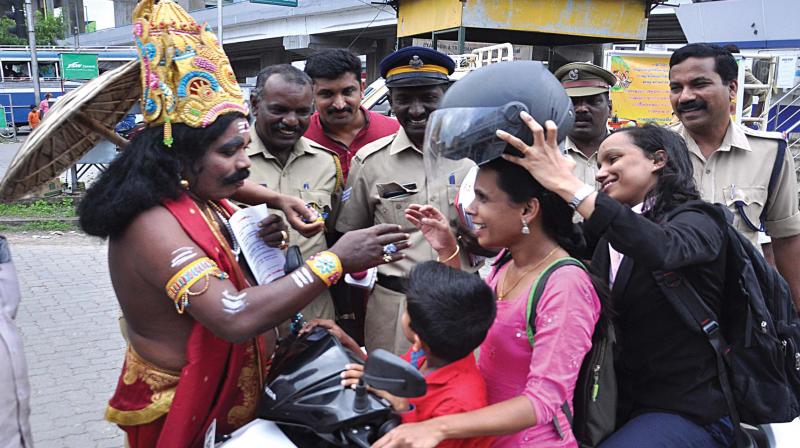Helmets for whose sake?

KOCHI: Take a look at the roads as a flurry of vehicles pass by, especially two-wheelers. One can see that many do not wear a helmet, especially on roads that pass through the interior parts. 99 per cent of the pillion-riders skip it and if one has a child sitting or standing in front or is on the lap of the pillion-rider, it is virtually a rule that they don’t wear helmets, thereby risking many lives. A glance at the available data confirms it. About 28 two-wheeler helmetless riders died daily on Indian roads in 2016, according to data shared by states with the Union Transport Ministry. “That year was the deadliest with 31 people dying in every 100 road accidents. It has steadily increased from 21.6 deaths per 100 accidents in 2005 to 29.1 in 2015,” the data shows.
States have reported that one of every five bike occupants who died in crashes was not wearing a helmet. The total number of road deaths was nearly 1.51 lakh in 2016 compared to 1.46 lakh in 2015. About 68 per cent of the people killed was in the 18-45 years age group. According to the Ministry of Surface Transport’s report titled ‘Road accidents in India 2015-2016’ as many as 52,500 people were killed in accidents involving two-wheelers in 2015 alone which is about 35 percent of the total road accident related deaths in the country. The share of two-wheelers in the mishaps jumped from 28 per cent in 2014 to more than 35 percent in 2016 across the country.
Most fatalities are blamed on the riders not wearing helmets or using substandard ones. The Motor Vehicles Act, 1988, makes it mandatory for all two-wheeler riders to wear ISI-marked headgear. The penalty at present is Rs 600 for the first violation. But implementation of these provisions leaves much to be desired. The Global Status Report on Road Safety 2015 says wearing a quality helmet can reduce the risk of death by almost 40 per cent and the risk of severe injury by approximately 70 per cent. Section 129 of the Motor Vehicles Act says, “Every person driving or riding (other than in a side car, on a motor cycle of any class or description) shall, while in a public place, wear protective headgear conforming to Bureau of Indian Standards (BIS).”
“Many of the substandard helmets boast of the ‘ISI ‘mark which is an assurance of quality from BIS. Needless to say, more often than not even the ‘ISI’ mark on these substandard quality helmets which are freely available on roadside stalls is found to be fake. This is not just a case of cheating the customers but in a sense also amounts to endangering their lives. These killer substandard helmets which are available for as little as '100 at roadside stalls have become a common sight across the country,” says Shailendra Jain, group head, sales and marketing, Steelbird Global, a helmet-making firm.
“A helmet manufacturer with BIS-approved product doesn’t use stickers or labels. Roadside vendors simply paste fake ISI logos on the helmets. Even a Ministry of Road Transport committee has recommended that mandatory ISI marking scheme should be implemented to eradicate the thriving substandard helmet market while also suggesting “heavy penalty” for its effective implementation. The committee feels that specifications related to quality for safety cannot be compromised for reducing the cost,” he says. ISI marks for the helmets are approved after stringent tests like impact absorption, resistance to penetration, rigidity and dynamic test of retention system apart from audibility and visibility. Cities like Kochi, Bangalore, Guwahati, Pune, Hyderabad, Panaji, Ludhiana are known as a biker’s hub, where people are fascinated by bikes.
“All over India 7 to 8 per cent users (drivers) wear helmets while in Kerala this is 45 percent. In the case of pillion riders, the all-India percentage is 1 while in Kerala this is 2 to 5 percentage,” said Shailendra Jain. The requirement in the country of helmets is 100 million pieces per year of which 20-30 percent sold are of BIS standards. The rest 70-80 per cent helmets are spurious. An increase of 35 per cent has been registered in the sale of helmets over the past five years. The organised market is worth Rs 600 crore currently. “In Kerala there is a policy for wearing helmets for drivers but it is not enforced. Tamil Nadu made it compulsory but again, there is no strict enforcement. Cities like Bangalore, Delhi and Jaipur have made it compulsory but Rajasthan and Karnataka have not. That is the paradox. The pillion rider is always left behind,” said Sherin Alunkal, one of the distributors of helmets in Kerala.

